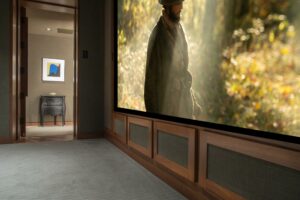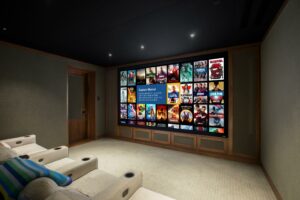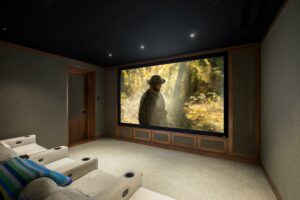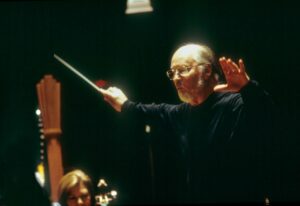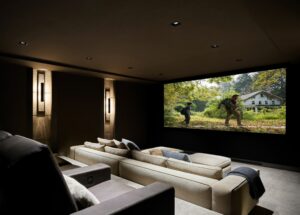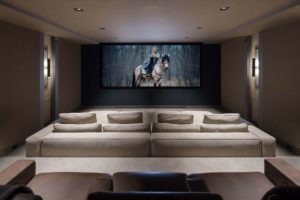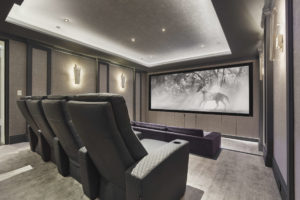Immersive Music, A Connoisseur’s Experience and Insight
FORWARD
As a musician, the term immersive music seems redundant. All music is immersive and should be presented that way. Unfortunately, for many today, music is not experienced immersively. The sensation of being in an ensemble, performances in intimate venues, or great halls is unknown to many. Immersive audio technology has afforded artists and engineers the ability to place us in that ensemble, that intimate venue, or grand hall. For those with well-engineered private cinemas the experience is compelling, the possibilities inspiring. Challenges however are emerging, not the least of which is an industry’s tendency to compromise and ignore the artists and connoisseurs seeking excellence. William Erb, a true connoisseur of rich listening experiences, whether music or film, shares why it is worth the effort for private cinema owners, designers and most importantly the artists and industry to pursue their potential. To experience music, the most powerful sonic experience, immersively, as it truly is.
Sam
I was recently browsing through new albums in Apple Music’s growing Dolby Atmos catalog and came upon Amazing Grace, a live recording from 1972 of Aretha Franklin singing gospel music in a Los Angeles church. I had already seen the identically titled 2018 documentary film of that remarkable event in 5.1 surround, so the material was not new to me. Even so, when I started listening to the immersive version of the album in my home theater, I was transfixed.
There are many times when an immersive recording has transported me to a seat in a concert hall. Often when the music ends the applause and cheers from an enthusiastic audience can make for great ear candy. There are other immersive recordings that have placed me in the middle of the performance space so that I feel literally bathed in the sound of musical instruments. Amazing Grace was something entirely new: an immersive recording where the spontaneous exclamations from members of the chorus and the audience as Aretha Franklin are singing was a vital part of experiencing the performance itself. The heightened emotional impact that this effect created, particularly on the title track towards the middle of the concert, took my breath away.
Playing Amazing Grace is not the only memorable immersive music listening experience I have had in my home theater. I have come to appreciate that my installation, with a 7.1.4 speaker layout, provides something that many musicians, music producers and record label executives will often struggle to find: access to a purposely designed, acoustically treated, and expertly calibrated immersive music listening room. In fact, it has been embarrassingly easy for me to use my home theater to listen to immersive music. Without any incremental effort or investment in new equipment, I can play lossless immersive recordings on Pure Audio Blu-ray discs through my Blu-ray player and stream Dolby Atmos music through Apple Music or Tidal on my Apple TV.
If you have a home theater that is properly engineered and equipped with a high-end 3D audio setup, then you may understandably want to experience Dolby Atmos music played in lossless Dolby TrueHD. For now, this is not possible through any of the streaming services, which are all using the lossy Dolby Digital Plus codec. This has not prevented me from enjoying music that I have streamed, including Amazing Grace as described earlier. I have found, however, that the best lossless recordings can offer a qualitatively different level of vividness, clarity, and punch.
Take, for example, the Norwegian label 2L. 2L albums are not remixes of prior recordings but conceived from the start as immersive productions. To quote from the 2L website:
2L record in spacious acoustic venues: large concert halls, churches and cathedrals. This is actually where we can make the most intimate recordings. The qualities we seek in large rooms are not necessarily a big reverb, but openness due to the absence of close reflecting walls….A really good recording should be able to bodily move the listener. This core quality of audio production is made by choosing the right venue for the repertoire, and by balancing the image in the placement of microphones and musicians relative to each other in that venue.
Most 2L albums feature stage layout diagrams and photos that enable the listener to orient themselves in relation to the various performers. Given 2L’s high production values, their albums sound good even when streamed. But listening to the lossless versions really enables me to appreciate the level of detail and care that goes into each recording.
Another niche label dedicated to immersive productions is IAN. Two IAN albums stand out to me for their distinctiveness: Alessandro Quarta plays Astor Piazzolla and Tetragon Project: Oracles. The first one is a great example of an immersive mix with a lot of punch that places the listener right in the middle of the band. You can hear the detail of every instrument and really feel the double bass. The second album is more experimental and highly immersive. I listen to it both with and without the accompanying video depending on my mood.
Until recently there were no simple alternatives to Blu-ray discs for delivering lossless immersive content to a home theater system. This may be changing, however, as I am now trying out another option that was very easy to implement: using an Nvidia Shield to play lossless Atmos and Auro-3D audio streams contained in MKV files. Anyone interested in this topic should definitely check out a recent article by Chris Connaker of Audiophile Style. What is particularly heartening is that we are starting to see some labels and distributors making immersive albums available as MKV file downloads (see for example the new 2L album Tuvayhun).
Until more immersive albums are released in lossless formats, many Atmos music recordings will only be available via Apple Music and other streaming services. Just because an Atmos album cannot be played in TrueHD does not mean it cannot be enjoyed by most people when played through an Apple TV in a home theater. You can even keep your projector off and control Apple Music on an iOS device with the Control Center TV remote. Browsing for Dolby Atmos music content on Apple Music can sometimes be exasperating because the quality of the immersive mixes is so variable, but hopefully, more reviewers will start publishing lists like this one from Immersive Audio Album on the Top 10 immersive singles on Apple Music.
It is still early days in the evolution of the immersive music ecosystem, so it is hard to predict which formats and platforms will be around for the long haul. For now, most people can only listen to immersive music recordings as binaural mixes through headphones. Although binaural renderers are improving in quality and can deliver an experience that is more immersive than listening to the same content in stereo, the listening experience through headphones still falls well short of what is possible with a decent set of speakers. If you have a home theater with a 3D speaker layout, all you need to do is press Play to get a high-quality immersive music listening experience. So why not sit back, put on some immersive music, and enjoy the ride?
